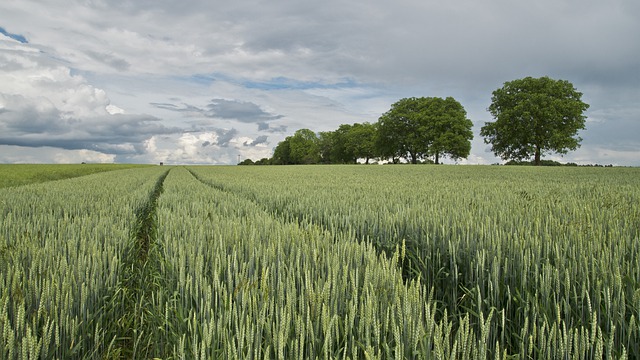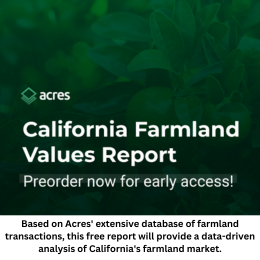August 15, 2022
By Ben Palen, Ag Management Partners
At this time each year (with rare exceptions), I make the trek to my family’s cemetery, located in a no-stop-light town deep in the heart of Kansas. Three generations have their final resting place there, and all of them share an agrarian heritage.
It is about a 1,000 mile round trip, and I always vary the route to and from the cemetery so that I can see the country from more than just the 75 mph vantage point of the interstate highways. One author wrote a book a couple of decades ago entitled Blue Highways, and those are the highways that I take on this journey – a journey on which, as I like to say, you can see to the horizon, and then some….
Much of this area was once described to me in the late 1970s by a long-time farmer as “promising you the least, and giving you the most,” or “promising you the most, and giving you the least.” It was traditionally wheat/fallow country, with the occasional field of grain sorghum.
The changes in this part of Kansas tend to mirror the changes that have occurred across the broad spectrum of agriculture in the United States. Corn and soybeans are very common, to the extent that wheat often takes a back seat, and many parts of this region are reminiscent of the Corn Belt, albeit with lower precipitation and lesser yields.
Farming practices have undergone a dramatic change over the past two decades or so, with the big majority of acres under a no-till program, and continuous cropping producing three crops in four years. These changed practices have brought an influx of crop input suppliers who formerly were focused on what were once considered more productive regions. Grain marketing opportunities have also increased by way of unit train loadouts, and far more on-farm storage capacity than would have ever been dreamed about in prior years.
To borrow a phrase from a classic song by the Eagles (and to alter it slightly) what comes to mind when considering these changes is that “every form of growth has its price.” In this case, there has been consolidation of farms and pressures on small towns to remain viable. The price of entry for a young farmer is now beyond reach for many—barring some creative solutions, and the lure of the big city has caused many people not to return to the farm where they grew up.
With change comes challenges, and opportunities. By driving those blue highways, and talking to folks along the way, one can gain a better understanding of what is taking place in these areas. In some respects, the introduction of a broad range of technologies into agriculture has brought some younger generations back to the farm, and helped a lot of the small towns that serve critical social and economic purposes in these areas. To be sure, there are exceptions to the rule, but a drive in and around many of the county seats offers a bird’s eye view of the level of community pride. It shows in the condition of the main street storefronts, and on the farmsteads.
The widespread use of technology has led to a number of positive things, including (a) greater ability for farmers to spread their financial and operating risks; (b) alternative uses for certain crops (notably corn-based ethanol in the mid 2000s, and soy-based fuels in more recent years); (c) reductions in soil and water erosion, and increases in overall soil health; and (d) more responsible use of resources that are essential to optimal crop yields.
The evolution of how agriculture is capitalized has also come into the picture, and I think in mostly positive ways. As noted, the barriers to entry for a young person are very high, but the rise of investor interest in farmland has created opportunities for farmers to align themselves with these capital sources in ways that were not even on the drawing board in the 1990s. There is more competition among lenders (traditional as well as newer entrants) to gain the business of farmers, and generally speaking, the availability of capital is not a constraint.
Many of the changes that I have observed firsthand in this part of Kansas are not unique to that area. Arguably, though, the massive change from the wheat/fallow rotation to a crop mix that is now very diverse is vastly different than, say, the Corn Belt, where the corn/soybean rotation is largely unchanged.
Notwithstanding the changes that I have noted in this article, the essence of agriculture in this area is unchanged. And that message comes through loud and clear via many insights gained from speaking with farmers and others in agriculture in this small slice of America. That essence is the pride that comes from planting seeds and seeing the results of one’s efforts. That is what drives these farmers to succeed despite the obstacles that are often put in their way. It was that way when my grandfather farmed with a team of horses pulling the plow in the late 19th century, and is the case today with a 24 row planter placing seed and fertilizer with precision at variable rates.
ABOUT THE AUTHOR:
Ben Palen is a fifth generation farmer with experience in many aspects of agriculture, including projects in the United States, Africa, and the Middle East. The focus on all projects is sustainable practices based on a mix of boots on the ground work and selected use of agtech tools.
*The content put forth by Global AgInvesting News and its parent company HighQuest Partners is intended to be used and must be used for informational purposes only. All information or other material herein is not to be construed as legal, tax, investment, financial, or other advice. Global AgInvesting and HighQuest Partners are not a fiduciary in any manner, and the reader assumes the sole responsibility of evaluating the merits and risks associated with the use of any information or other content on this site.

Let GAI News inform your engagement in the agriculture sector.
GAI News provides crucial and timely news and insight to help you stay ahead of critical agricultural trends through free delivery of two weekly newsletters, Ag Investing Weekly and AgTech Intel.




